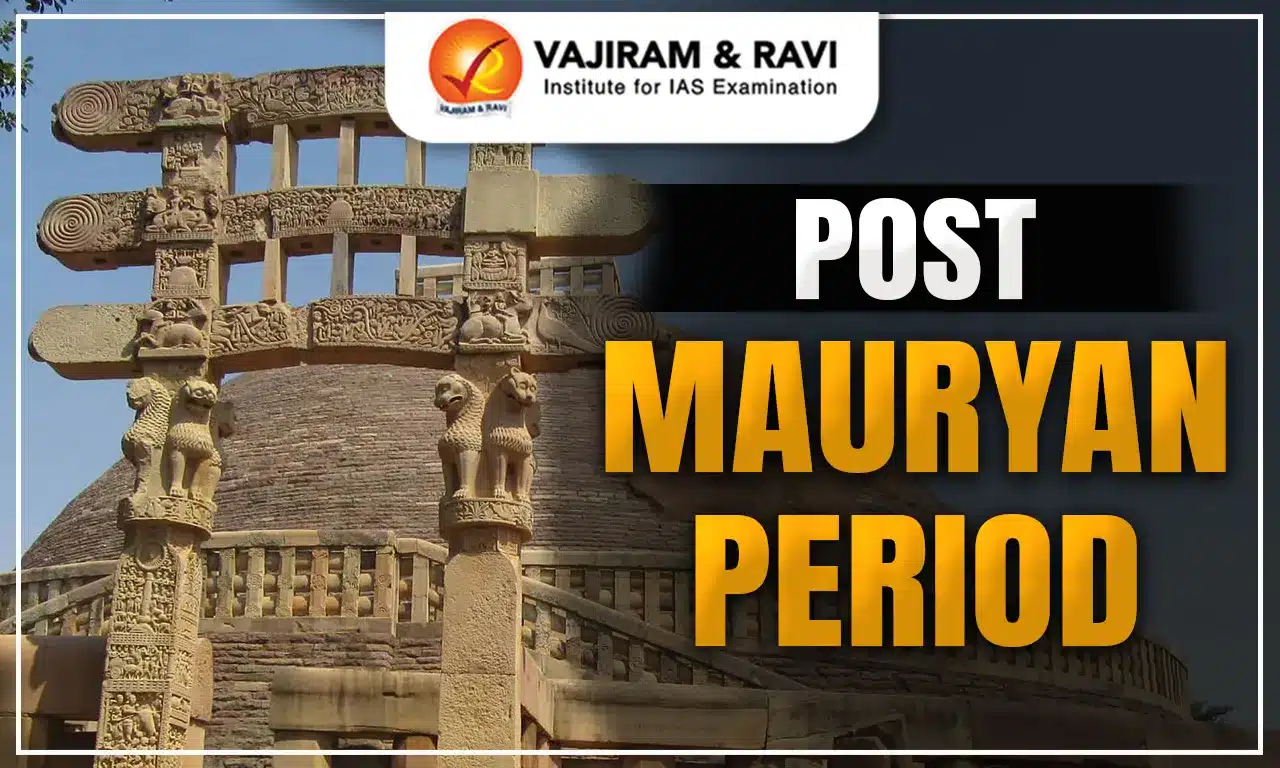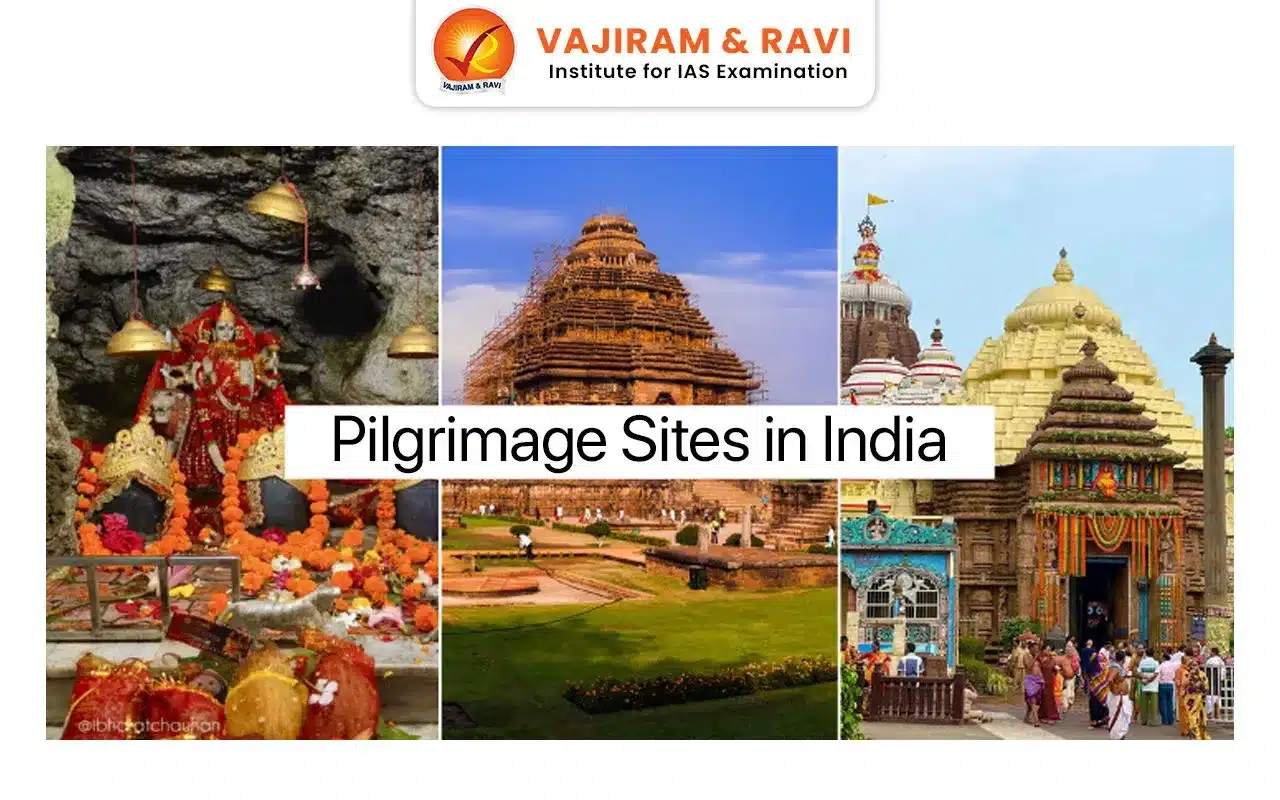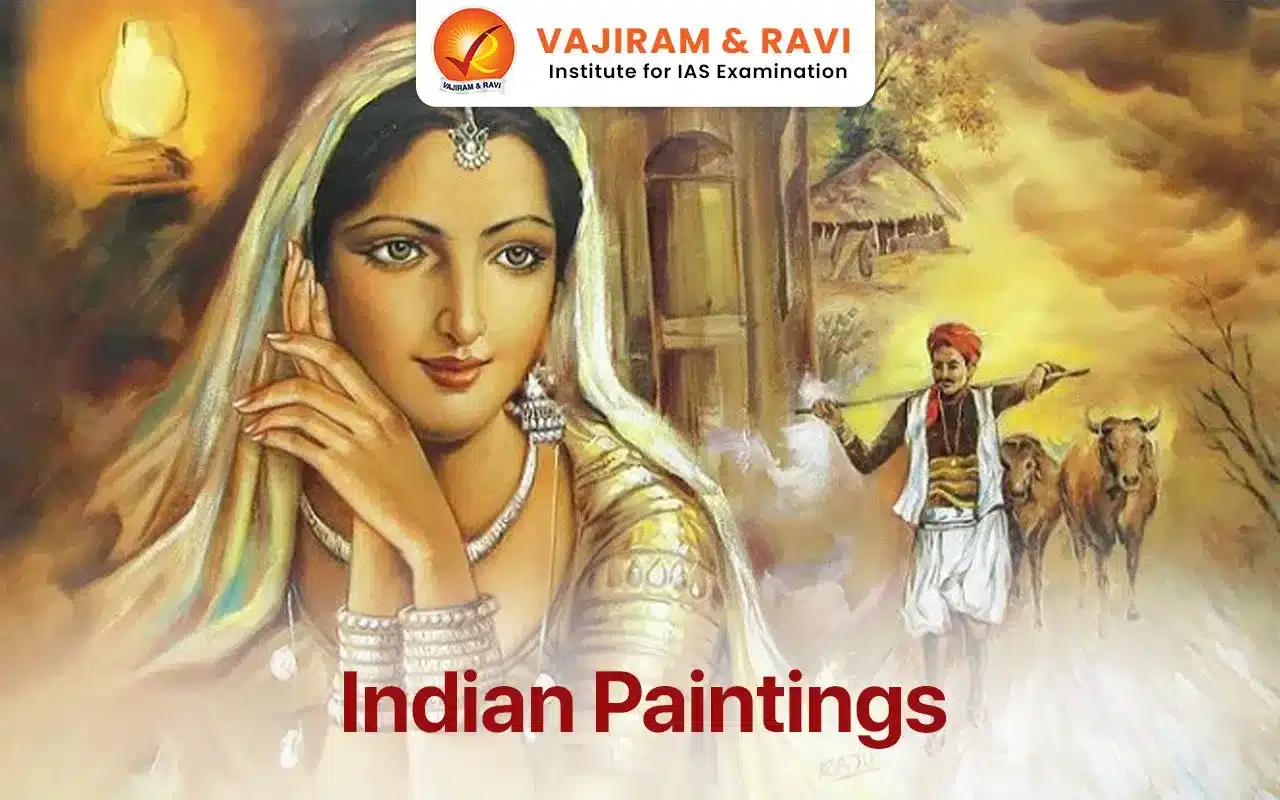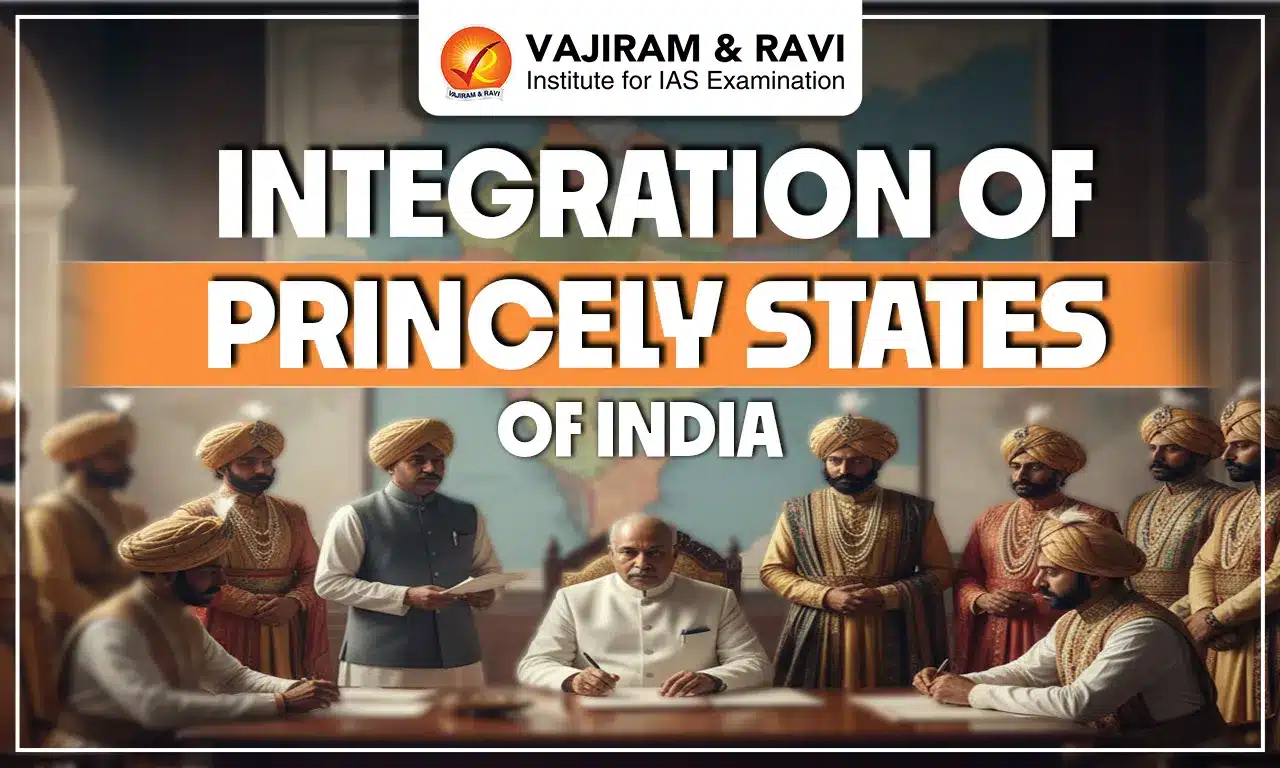The Post Mauryan Period between the fall of the Mauryas and the rise of the Guptas (2nd century BC to 3rd century AD), saw significant developments in the Indian subcontinent, which were characterised by changes in the subcontinent's political structure and the introduction of new elements in art, architecture, and religion.
The Mauryan Empire ruled over a large portion of the Indian subcontinent, including modern-day Afghanistan's Kandahar. The Mauryan Empire came to an end around 187 BC. The disintegration of the Mauryan empire resulted in the rise of numerous regional kingdoms and at the same time, various groups of people from Central Asia and western China invaded India which forms part of the Post Mauryan Period.
Political History during Post Mauryan Period
Following Asoka's death, his successors were unable to maintain the huge Mauryan Empire. The subsequent rulers were relatively weak and lacked the same level of administrative and military capabilities as their predecessors.
- The provinces started declaring their independence.
- The Mauryas lost control of northwest India, and the region was subjected to a series of foreign invasions.
- Kalinga declared its independence, and the Satavahanas established their independent rule further south.
- The religious policy of the Mauryas angered the Shungas, who were staunch followers of Brahmanism.
- Thus, Mauryan rule was confined to the Gangetic Valley, and it was soon replaced by the Sunga dynasty.
Shunga Dynasty
| Shunga Dynasty | |||||
| Period: 185 BC - 73 BC | Capital: Pataliputra and Vidisha | ||||
|
- It was founded by Pushyamitra Shunga by assassinating the last Mauryan ruler, Brihadratha. - They ruled over northwestern and central India and up to the Narmada in the south. - They protected the Gangetic Valley from incursions from outside forces. |
|||||
|
Pushyamitra Shunga (185 – 149 BCE) |
- He led a campaign against Kalinga kingKharavela. - He ran a number of campaigns against the Indo-Greeks known as Yavanas, who were attempting to invade northwest India from Bactria during this time. - He performed Ashvamedha to legitimise his right to rule. Dhandeva's Ayodhya Inscription mentions him performing two Ashwamedha Yagyas. - Although he was an ardent adherent to orthodox Hinduism, he renovated the Buddhist Stupa in Bharhut. - Contemporary to Patanjali (author of Mahabhasya) - His history was recorded in Banabhatta’s Harshacharita. |
||||
|
Agnimitra (149 – 141 BC) |
- “Malvikagnimitra”, a Sanskrit drama written by Kalidasa, is related to him and is based on the love between Vidharbha princess Malvika and Sunga king Agnimitra. | ||||
| Other Rulers |
- Vasumitra, Vajramitra, Bhagabhadra, Devabhuti (Last ruler). - Devabhuti, the last ruler of the Shunga dynasty, was assassinated by his minister Vasudeva Kanva, thus ending the Shunga empire. |
||||
| Administration of Shungas | |||||
|
- The Mauryan administration in the provinces through royal princes continued, and royal authority tended to diffuse through the emergence of nuclear kingdoms. - Royal power tended to decentralise in the form of the establishment of nuclear kingdoms within the empire. - The empire was divided into provinces. The provinces were further divided into districts or Janapadas. - The head of the administration was the king, who was assisted by a council of ministers (Mantriparishad). The king was responsible for the overall administration of the empire and was advised by the council of ministers on matters of policy and governance. |
|||||
| Contribution of Shungas to Art, Architecture and Literature | |||||
|
Bharhut Stupa (place)
|
- Discovered by Cunninghum. - Originally built by Ashoka but enlarged and renovated during the Shunga period in the mid-2nd century BC. - Situated in Satna district of Madhya Pradesh. - It is important for its sculptures. Red stone was used to make the railings. - It represents the beginning of a Buddhist narrative relief and decoration tradition for holy structures. E.g. Queen Mayadevi’s dream and depiction of Ruru Jataka. |
||||
|
Sanchi Stupa (Vidisha, Madhya Pradesh)
|
- Discovered by General Taylor. - Originally built by Ashoka but enlarged and renovated during the Shunga period (2nd century BC). - Situated in the trading route of Dakshinapatha. - Known for the lavish carvings on its decorated gateways /torans built during Satavahanas. - Figurines in Sanchi, though small, are very naturalistic. - Jataka stories are an important part of the narratives. |
||||
|
Heliodorus Pillar (near Vidisha, Madhya Pradesh)
|
- Stone column erected by Heliodorus, the Greek ambassador to the court of the Shunga king Bhagabhadra, around 150BC - Erected in honour of the god Vasudeva. - The inscription on the Pillar became famous as the Besnagar Inscription. - It reveals that the Shungas continued the Maurya tradition of entertaining ambassadors from the Greek court. |
||||
Kanva Dynasty
| Kanva Dynasty | |
| Period: 73 BC-28 BC | Capital: Pataliputra and Vidisha |
|
- It was founded by Vasudeva Kanva (minister of Shunga King Devabhuti), who killed the last Shunga ruler Devabhuti. - Bana, the 7th-century Sanskrit author, gives details of an assassination plot that cost Devabhuti (Devabhumi) his life and brought Vasudeva to power in about 72 BCE. - They were Brahmins and are considered descendants of Sage Saubhari. - Rulers after Vasudeva: Bhumimitra, Narayana, Susharman (last king). - Coins with the legend Bhumimitra have been found in the Panchala kingdom. - It ruled for a very short period. Susharman, the last Kanva ruler, was assassinated by Balipuccha of the Andhra dynasty. |
|
Chedi Dynasty
| Chedi Dynasty | ||
| Period: 1st century BCE | Capital: Suktimati-Puri | |
|
- Founded by King Abhichandra in Kalinga around the 1st century BC, with Suktimati-Puri as its capital on the banks of the Suktimati river. - Also known as Cheta or Mahameghavahana, or Chetavamsa. - After Ashoka, Kalinga (present-day Orissa) became prominent under the kings of the Chedi dynasty. - Except for Kharavela, there is no information on the dynasty's kings. |
||
| King Kharvela |
- Ruled approximately around the first century BCE. - His achievements are recorded in the Hathigumpha inscription, situated in the Udayagiri hills near Bhuvaneshvar in Orissa. - A follower of Jainism. - Succeeded by his son Kudepasiri, who is mentioned in an inscription found in the Mancapuri Cave. |
|
|
Udayagiri and Khandagiri Caves (Odisha)
|
- Made in the first or second century BC close to the present-day Bhubaneswar under the Kalinga King Kharavela. - Has both artificial and natural caves (possibly carved out as residence of Jain monks). - Famous for the Hathigumpha inscription, carved out in Brahmi script, which starts out with “Jain Namokar Mantra” and highlights various military campaigns undertaken by King Kharavela. - The double-storey Ranigumpha cave in Udayagiri is home to some exquisite sculptures. |
|
Art and Architecture of Post Mauryan Period
The art of the Post Mauryan Period started reflecting the changing socio-political scenario as well. The architecture of rock-cut caves and stupas proceeded, with each dynasty introducing its own distinctive features. Similarly, various schools of sculpture arose, and the art of sculpture reached its pinnacle in the post-Mauryan period.
- Development of Stupas: Stupas are Buddhist commemorative monuments usually housing sacred relics associated with the Buddha or other saintly persons.
- Three prominent stupas from this period can be found in Bharhut and Sanchi (both in Madhya Pradesh), which were originally constructed by Ashoka but later expanded, as well as Amravati and Nagarjunkonda (both in Andhra Pradesh).
- Stupas became larger and more decorative in the Post Mauryan period. Stone was increasingly used in place of wood and brick.
- The Shunga dynasty introduced the idea of torans as beautifully decorated gateways to the stupas.
- Early Temples Architecture:
- During this time, Brahmanical temples and images of gods began to be built.
- Myths mentioned in the Puranas were incorporated into the narrative representation of Brahmanical religion.
- Temples were decorated with the images of gods.Each temple had an image of a Chief Deity. These temples are basic structures that include a hall, a veranda, and a shrine in the back.
- Important temple sites of this period: Deogarh in Uttar Pradesh, Eran, Nachna-Kuthara and Udayagiri near Vidisha in Madhya Pradesh.
- There were three types of temple shrines: Sandhara type (without pradikshinapatha), Nirandhara type (with pradakshina patha) and Sarvatobhadra (accessible from all sides).
Religion and Society of Post-Mauryan Period
Religion and society during the post-Mauryan period witnessed the following changes.
- Rise of Brahmanism: People in the post-Mauryan period practised Vedic religion, Buddhism, and Jainism. However, Brahmanism experienced a resurgence under Shunga's rule. There was an increase in rituals such as Ashwamedha and Rajasuya.
- Stories of Pushyamitra's brutality and hostility against Buddhism are described in the Divyavadana.
- Varna system: During the post-Mauryan period, the four-fold varna system was also revived. Thus, the social structure became rigid as the fourfold varna system was strengthened. The dominance of priests and the ruling class was strengthened, while the conditions of Shudras remained unchanged.
- Position of women: Women's position in society was generally limited to domestic roles, and they were expected to follow strict codes of conduct as mentioned in the Manusmriti.
- Cultural expanse: It was the period of the emergence of various mixed castes and the integration of foreigners into Indian society.
Language and Literature of the Post-Mauryan Period
The Post-Mauryan period was significant for the development of Sanskrit for religious, philosophical, and literary works.
- Sanskrit became more popular during this period and was used to write Buddhist texts also.
- Patanjali: His important works include: Yoga Sutras (a collection of Sanskrit sutras (aphorisms) on the theory and practice of yoga), Mahabhasya (an ancient treatise on Sanskrit grammar and linguistics) and Patanjali Tantra (medical text).
- The Sanskrit language was written using the variant version of Brahmi script. It is believed that the writing serves as a link between the Kalinga Brahmi script and the Maurya script.
Trade and Commerce in Post Mauryan Period
The Post Mauryan period witnessed the flourishment of commerce and crafts in ancient India and the growth of internal and external trade and commerce.
- Craft and commerce:Jyestha was the head of the guild of artisans. Mathura was famous for the production of shataka, a unique kind of cloth.
- Merchant class: During this period, trade flourished and resulted in the rise of many types of merchant guilds.
- Shreshti led the merchant guild (shreni), while Sarthavaha led the sartha (mobile or caravan trading corporation). Vanijgramo was the head of the corporation of merchants.
- Trade routes:
- Uttarapatha was the internal trade land route connecting northern and eastern parts of India with the northwestern areas.
- Dakshinapatha was the trade land route connecting peninsular India with the western and northern parts of India.
- Discovery of monsoon: Discovery of monsoon led to the development of external trade.
- Export of spices to the Romans and import of gold and silver from Romans was common.
Around the same time, 200 BCE, there were invasions from Central Asia and western China. Among these were the Indo-Greeks, Scythians or Shakas, Parthiansor Pahlavas, and Kushanas. These invasions not only altered the political structure of northwestern India but also contributed to the transmission and transformation of cultural elements from both India and the Central Asian region.
Last updated on January, 2026
→ Check out the latest UPSC Syllabus 2026 here.
→ Join Vajiram & Ravi’s Interview Guidance Programme for expert help to crack your final UPSC stage.
→ UPSC Mains Result 2025 is now out.
→ UPSC Notification 2026 is scheduled to be released on January 14, 2026.
→ UPSC Calendar 2026 is released on 15th May, 2025.
→ UPSC Prelims 2026 will be conducted on 24th May, 2026 & UPSC Mains 2026 will be conducted on 21st August 2026.
→ The UPSC Selection Process is of 3 stages-Prelims, Mains and Interview.
→ Prepare effectively with Vajiram & Ravi’s UPSC Prelims Test Series 2026 featuring full-length mock tests, detailed solutions, and performance analysis.
→ Enroll in Vajiram & Ravi’s UPSC Mains Test Series 2026 for structured answer writing practice, expert evaluation, and exam-oriented feedback.
→ Join Vajiram & Ravi’s Best UPSC Mentorship Program for personalized guidance, strategy planning, and one-to-one support from experienced mentors.
→ UPSC Result 2024 is released with latest UPSC Marksheet 2024. Check Now!
→ UPSC Toppers List 2024 is released now. Shakti Dubey is UPSC AIR 1 2024 Topper.
→ Also check Best UPSC Coaching in India
FAQs on Post Mauryan Period
Q1. What is the Post Mauryan period?+
Q2. What was the Post-Mauryan period known for?+
Q3. Who founded the Shunga dynasty, and what were their capital cities?+
Q4. Who was the famous scholar in the court of Pushyamitra Sunga?+
Q5. What is the significance of the Hathigumpha inscription, and who is associated with it?+
Tags: post mauryan period quest























